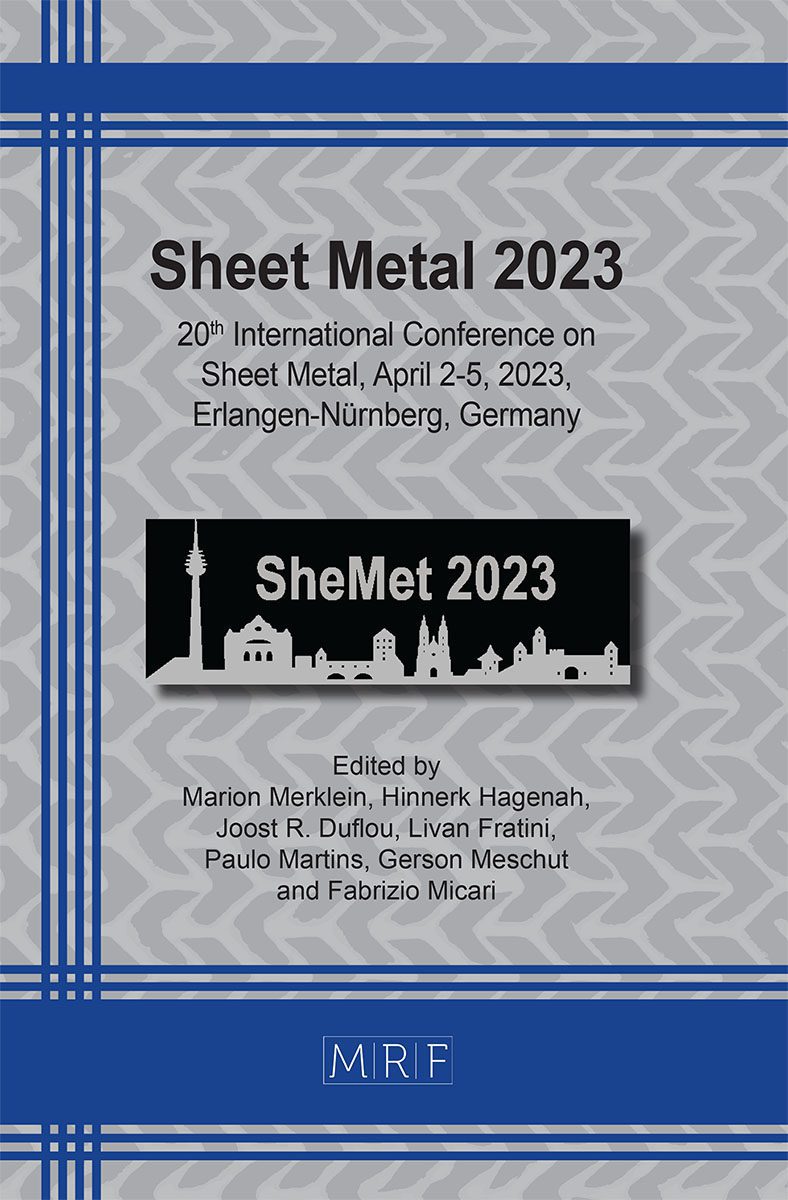Methodical approach for the design and dimensioning of mechanical clinched assemblies
Christoph Zirngibl, Sven Martin, Christian Steinfelder, Benjamin Schleich, Thomas Tröster, Alexander Brosius, Sandro Wartzack
download PDFAbstract. The focus towards multi-material and lightweight assemblies, driven by legal requirements on reducing emissions and energy consumptions, reveals important drawbacks and disadvantages of established joining processes, such as welding. In this context, mechanical joining technologies, such as clinching, are becoming more and more relevant especially in the automotive industry. However, the availability of only few standards and almost none systematic design methods causes a still very time- and cost-intensive assembly development process considering mainly expert knowledge and a considerable amount of experimental studies. Motivated by this, the presented work introduces a novel approach for the methodical design and dimensioning of mechanically clinched assemblies. Therefore, the utilization of regression models, such as machine learning algorithms, combined with manufacturing knowledge ensures a reliable estimation of individual clinched joint characteristics. In addition, the implementation of an engineering workbench enables the following data-driven and knowledge-based generation of high-quality initial assembly designs already in early product development phases. In a subsequent analysis and adjustment, these designs are being improved while guaranteeing joining safety and loading conformity. The presented results indicate that the methodological approach can pave the way to a more systematic design process of mechanical joining assemblies, which can significantly shorten the required number of iteration loops and therefore the product development time.
Keywords
Joining, Structural Analysis, Machine Learning
Published online 3/17/2023, 8 pages
Copyright © 2023 by the author(s)
Published under license by Materials Research Forum LLC., Millersville PA, USA
Citation: Christoph Zirngibl, Sven Martin, Christian Steinfelder, Benjamin Schleich, Thomas Tröster, Alexander Brosius, Sandro Wartzack, Methodical approach for the design and dimensioning of mechanical clinched assemblies, Materials Research Proceedings, Vol. 25, pp 179-186, 2023
DOI: https://doi.org/10.21741/9781644902417-23
The article was published as article 23 of the book Sheet Metal 2023
![]() Content from this work may be used under the terms of the Creative Commons Attribution 3.0 licence. Any further distribution of this work must maintain attribution to the author(s) and the title of the work, journal citation and DOI.
Content from this work may be used under the terms of the Creative Commons Attribution 3.0 licence. Any further distribution of this work must maintain attribution to the author(s) and the title of the work, journal citation and DOI.
References
[1] J. Mucha, L. Kascak, E. Spisak, Joining the carbody sheets using clinching process with various thickness and mechanical property arrangements. Archives of Civil and Mechanical Engineering 11(1) (2011) 135-148. https://doi.org/10.1016/S1644-9665(12)60179-4
[2] R. Rzasinski, L. Kochanski, Joining methods in car body construction. IOP Conf. Ser.: Mater. Sci. Eng. 400022051 (2018). https://doi.org/10.1088/1757-899X/400/2/022051
[3] J.P.M. Pragana, R.F.V. Sampaio, I.M.F. Bragança, C.M.A. Silva, P.A.F. Martins, Injection Lap Riveting of Aluminum Busbars – A Thermo-Electro-Mechanical Investigation. J. Manuf. Mater. Process, 74(6) (2022). https://doi.org/10.3390/jmmp6040074
[4] M. Gude, G. Meschut et al., FOREL-Studie – Chancen und Herausforderungen im ressourcen-effizienten Leichtbau für die Elektromobilität. Dresden, (2015). ISBN 978-3-00-049681-3.
[5] L. Kascak, E. Spisak, J. Majernıkova, Clinching and Clinch-Riveting as a Green Alternative to Resistance Spot Welding. 2019 International Council on Technologies of Environmental Protection (ICTEP) (2019) 138-142. https://doi.org/10.1109/ICTEP48662.2019.8968973
[6] R. Neugebauer, F. Riedel, R. Marx, Entwicklung eines Konstruktionssystems für den rechnerischen Festigkeitsnachweis von punktförmig mechanisch gefügten Bauteilen. EFB-Forschungsbericht 323, EFB Hannover (2010). ISBN: 978-3-86776-359-2
[7] D. W. Kelly, M. Elsley, A procedure for determining load paths in elastic continua, Eng. Comput. 12 (1995) 415-424. https://doi.org/10.1108/02644409510799721
[8] K. Marhadi et al., Comparison of Quantitative and Qualitative Information Provided by Dif-ferent Structural Load Path Definitions, Int. J. Simul. Multidiscip. Des. Optim. 3 (2009) 384-400.
[9] C. Steinfelder, A. Brosius, A New Approach for the Evaluation of Component and Joint Loads Based on Load Path Analysis, Lect. Notes Prod. Eng. (2020) 134-141. https://doi.org/10.1007/978-3-662-62138-7_14
[10] C. Steinfelder, S. Martin, et al., Load Path Transmission in Joining Elements, Key Eng. Mater. 883 (2021) 73-80. https://doi.org/10.4028/www.scientific.net/KEM.883.73
[11] C. Zirngibl, C. Sauer, et al., Knowledge and Data-Based Design and Dimensioning of Mechanical Joining Connections. ASME IDETC-CIE 2022, St. Louis Missouri (2022). https://doi.org/10.1115/DETC2022-89172
[12] C. Zirngibl et al., Application of reinforcement learning for the optimization of clinch joint characteristics. Prod. Eng. 16 (2022) 315-325. https://doi.org/10.1007/s11740-021-01098-4
[13] W.-G. Drossel, W. Israel, Sensitivitätsanalyse und Robustheitsbewertung beim mechani-schen Fügen. EFB-Forschungsbericht 376, Hannover, (2013). ISBN: 978-3-86776-419-3































